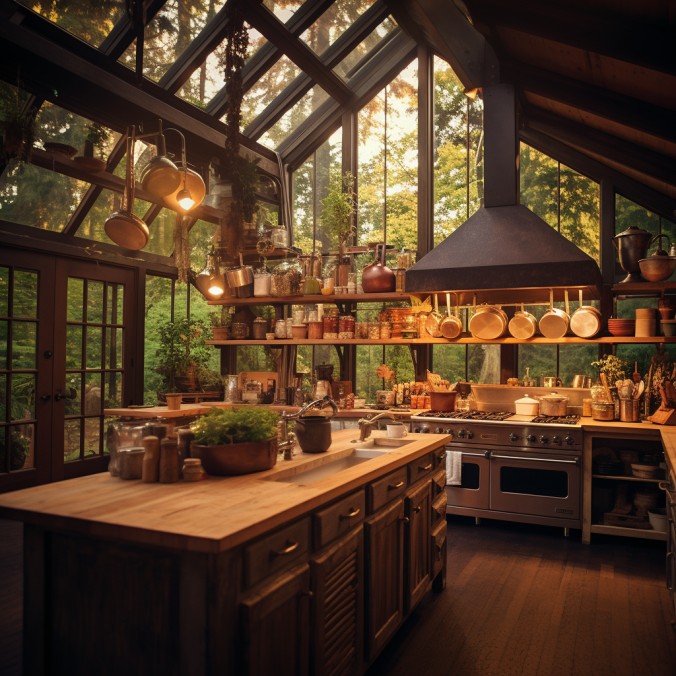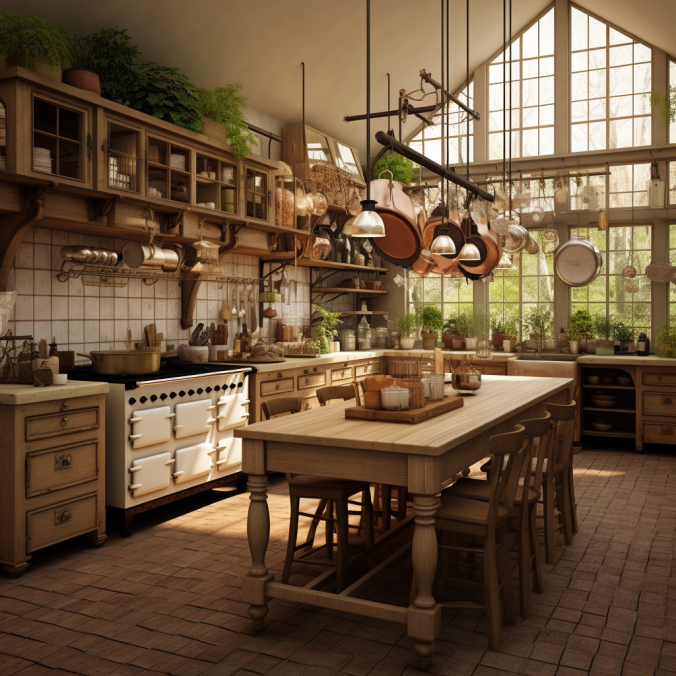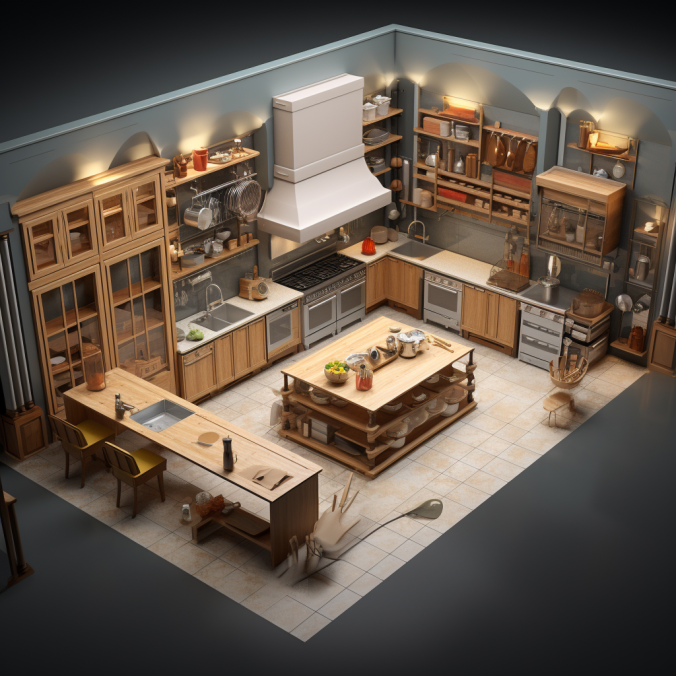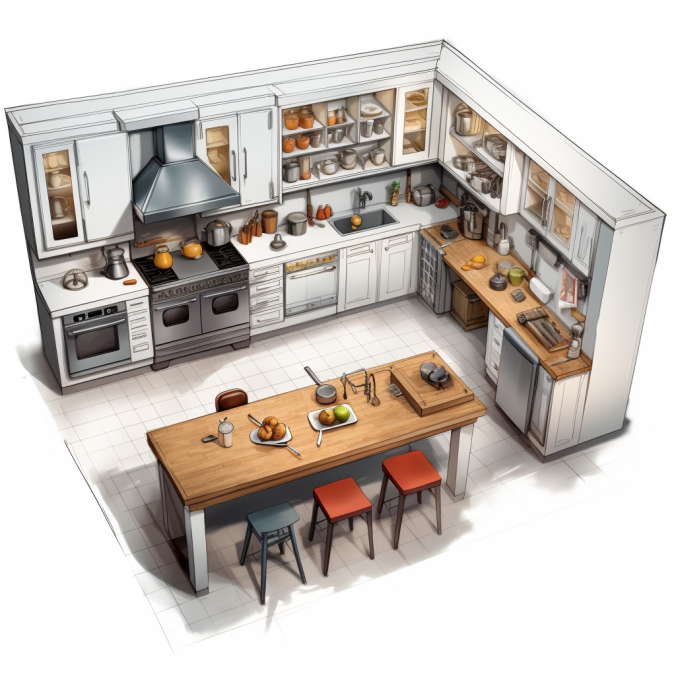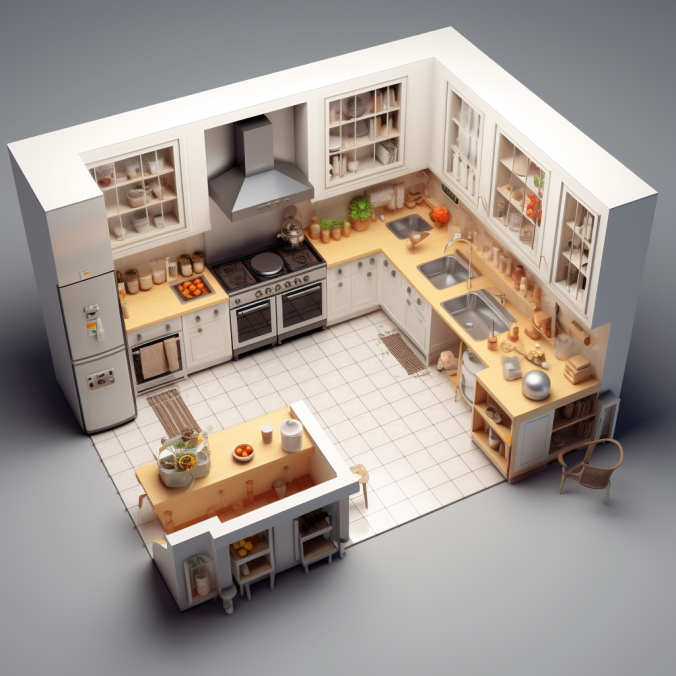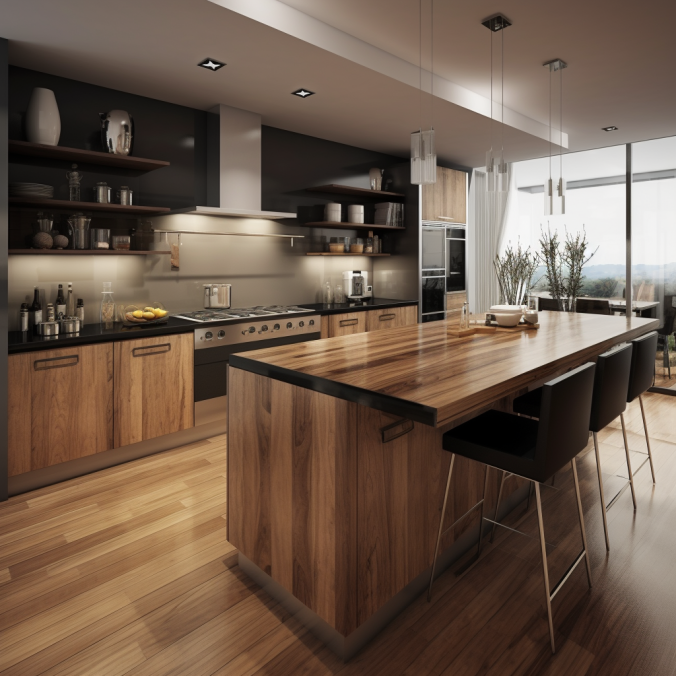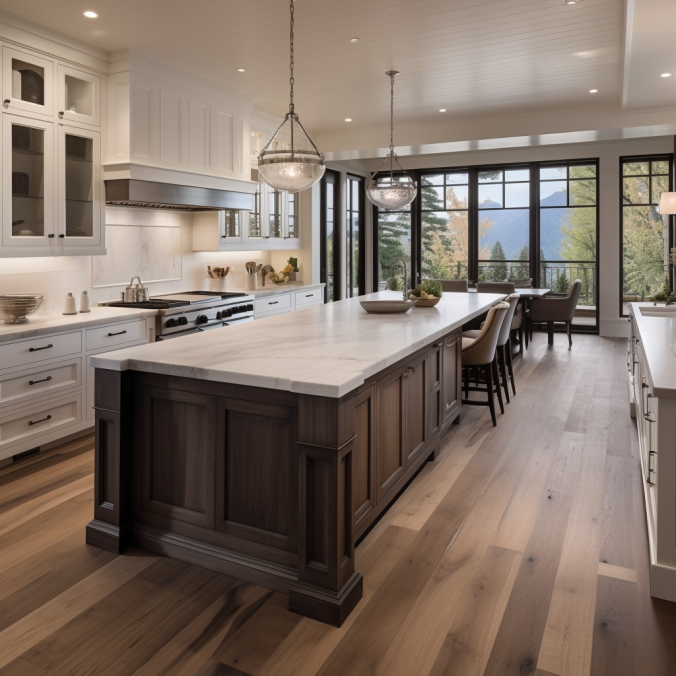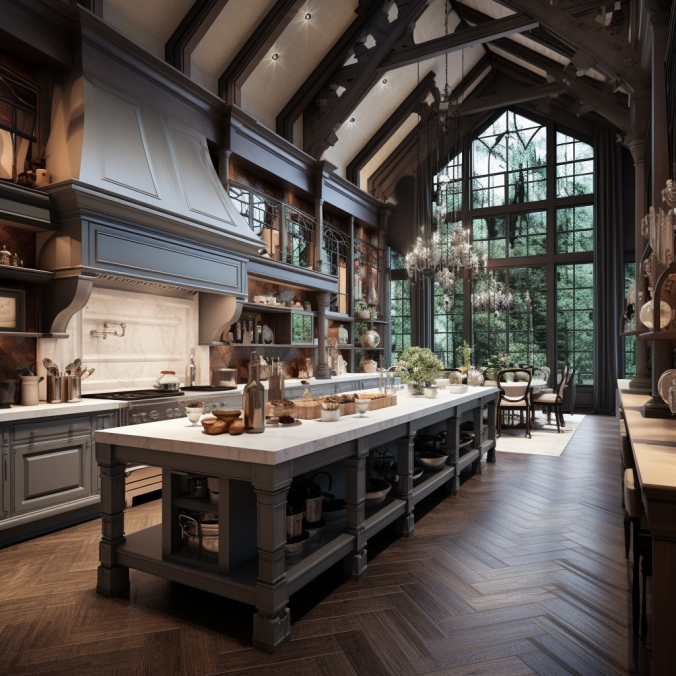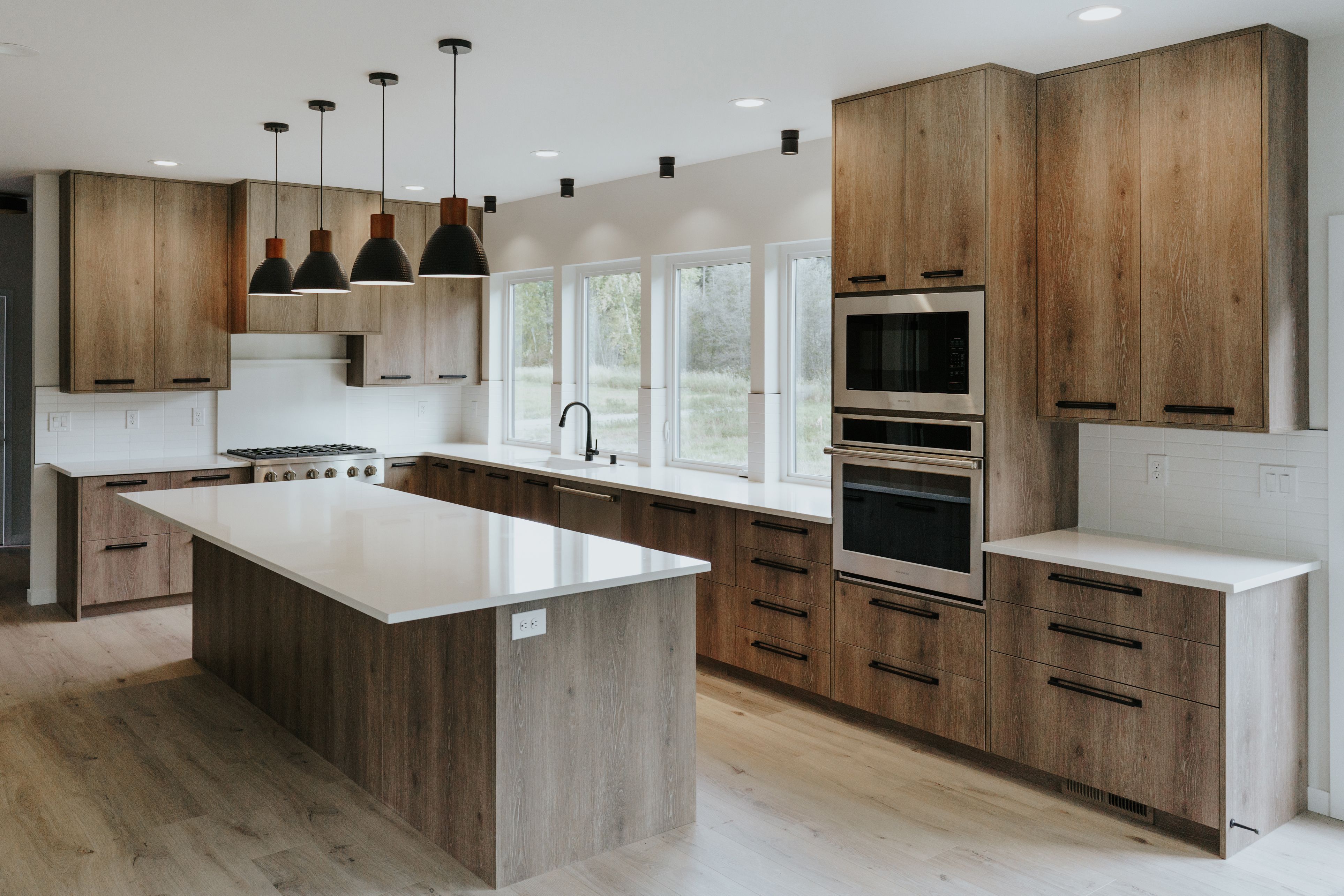
The Anatomy of the Perfect Kitchen: Key Factors to Consider
Discover the essential elements that contribute to the perfect kitchen design. Get expert insights on layout, materials, appliances, and more.
Perfect Kitchen: Key Factors to Consider
When it comes to designing the perfect kitchen, there are several key factors to consider. From the layout and organization to the materials and appliances, every detail plays a crucial role in creating a functional and stylish cooking space. One of the most important elements is the kitchen cabinets. Cabinets not only provide essential storage but also add aesthetic appeal to the overall design. Custom cabinets are the preferred choice for many homeowners as they offer flexibility in design and can be tailored to specific needs and preferences. Quality cabinets are another crucial consideration as they ensure durability and longevity. Opting for premium cabinets made from solid wood, such as birch, not only adds natural beauty to the kitchen but also guarantees a high-quality product. Additionally, choosing the right cabinet hardware is essential for both functionality and style. Whether it's the handles, knobs, or hinges, selecting the right hardware can make a significant difference in the overall look and feel of the kitchen.
What is a Perfect Kitchen?
A perfect kitchen is a harmonious blend of functionality, style, and quality. It is a space that not only meets your cooking needs but also enhances the overall aesthetics of your home. Several key elements come together to create the perfect kitchen.
Functionality is at the forefront when designing a perfect kitchen. The layout should allow for easy movement, with well-placed appliances and work surfaces. Ample storage is essential to keep all your pots, pans, and utensils organized. Custom cabinets offer a tailored solution, maximizing storage capacity and optimizing space utilization.
Quality materials are crucial for both durability and visual appeal. Premium cabinets constructed from solid wood, such as birch, not only exude natural beauty but also ensure long-lasting performance. Investing in custom cabinets crafted by skilled cabinet makers guarantees top-notch quality and attention to detail.
Lighting plays a vital role in enhancing the functionality and ambiance of a kitchen. Well-placed lighting fixtures, including overhead, task, and accent lighting, provide ample illumination for all activities, from prepping ingredients to dining.
Style is an inherent aspect of a perfect kitchen. It should reflect your personal taste and complement the overall aesthetics of your home. Whether you prefer a modern, minimalist design or a cozy, farmhouse-inspired space, there is a wide range of styles to choose from.
When creating a perfect kitchen, it is essential to consider your budget, sustainability, and ease of maintenance. Finding the right balance between these factors ensures a kitchen that is both functional and aesthetically pleasing, making it the heart of your home.
Functionality and Layout
A well-designed kitchen should prioritize functionality and optimize the layout for ease of movement and efficient workflow. An ideal kitchen layout minimizes the distance between key areas such as the sink, stove, and refrigerator, creating a seamless cooking experience. The work surfaces should be strategically placed to ensure easy food preparation, and there should be ample space for maneuvering between appliances. A thoughtfully designed kitchen layout not only enhances productivity but also contributes to a more enjoyable and stress-free cooking environment. With functionality at the forefront, every aspect of the kitchen's design and organization should be carefully considered to create a space that is both practical and visually appealing.
Importance of an efficient kitchen layout
An efficient kitchen layout is of utmost importance in ensuring the productivity and success of a foodservice establishment. A well-designed kitchen layout can minimize bottlenecks, enhance workflow, and improve staff production.
By strategically organizing the different components of a kitchen, such as workstations, appliances, and storage areas, an efficient layout allows for seamless movement and easy access to essential tools and ingredients. This not only saves time but also reduces the chances of accidents or mistakes.
In a fast-paced environment, where every second counts, an efficient kitchen layout can significantly improve the speed at which dishes are prepared and served. By reducing unnecessary movements and optimizing the arrangement of workstations, chefs and kitchen staff are able to work in a more organized and productive manner.
Additionally, a well-designed kitchen layout can also have a positive impact on staff morale. When the workspace is functional and ergonomic, employees are more likely to enjoy their work and feel motivated to perform at their best.
In summary, an efficient kitchen layout is essential for the smooth operation of a foodservice establishment. It not only increases productivity but also enhances staff production and overall success. By minimizing bottlenecks and optimizing workflow, a well-designed kitchen layout can maximize efficiency in every aspect of food preparation.
Discuss different kitchen layouts (e.g., galley, L-shaped, open-concep
There are several different kitchen layouts commonly used in both restaurant and residential settings, each offering its own advantages and disadvantages.
The galley layout is a popular choice for smaller spaces, featuring two parallel countertops with a walkway in between. This layout maximizes efficiency by keeping all appliances and storage within easy reach. However, the narrow space can feel cramped and limit social interaction.
The L-shaped layout is another common option, with countertops forming an "L" shape along two adjacent walls. This layout provides ample work surface and storage space, making it ideal for multiple cooks. It also allows for better traffic flow and can easily accommodate an island or dining area. However, the corner space can be challenging to utilize effectively.
Open-concept layouts are becoming increasingly popular, especially in residential settings. These layouts involve removing walls to create a seamless flow between the kitchen, dining, and living areas. This layout promotes social interaction, allows for natural light, and creates a spacious feel. However, it requires careful planning to ensure proper ventilation and noise control.
In addition to these traditional layouts, the island-style kitchen layout has gained popularity in large square kitchens. This layout features a center island that serves as additional workspace, storage, and a gathering area. It provides functionality and versatility, acting as a focal point while maintaining a sense of openness.
When considering the ideal kitchen layout, it's important to evaluate the available space, consider work efficiency and traffic flow, and prioritize the desired level of interaction and openness. Each layout has its own set of benefits and drawbacks, so it's crucial to choose one that aligns with your personal preferences and lifestyle.
Considerations for work triangle and traffic flow
Considerations for Work Triangle and Traffic Flow in the Kitchen
When designing the perfect kitchen, it is crucial to consider both the work triangle and traffic flow. These factors play a significant role in optimizing kitchen efficiency and ensuring ease of movement.
The work triangle consists of the distance between the refrigerator, sink, and stove, the three main areas of activity in the kitchen. This triangle should be properly optimized to minimize the distance and time spent moving between these key areas. The ideal distance between each point of the triangle should be within easy reach, allowing for efficient food preparation and cooking. By optimizing the work triangle, you can streamline your workflow and minimize wasted steps, ultimately making your time in the kitchen more productive.
Equally important is an unobstructed traffic flow throughout the kitchen. A well-designed kitchen should allow for easy movement between different areas, especially in high-traffic zones. Avoid placing large appliances or furniture in pathways, as this can hinder movement and create unnecessary obstacles. Additionally, ensure that door swings and cabinet openings do not impede the flow of traffic. By considering traffic flow, you can create a kitchen that promotes a smooth and seamless cooking experience.
In conclusion, when designing your kitchen layout, pay attention to the work triangle and traffic flow. A properly optimized work triangle and an unobstructed traffic flow can greatly enhance kitchen efficiency and make your cooking experience a breeze. Consider these factors to create a functional and well-designed space that meets your needs.
Get more detailed information about work triangle at our post.
Quality Materials and Appliances
When it comes to creating the perfect kitchen, one of the key factors to consider is the use of quality materials and appliances. The choice of materials not only affects the overall aesthetics but also plays a crucial role in the durability and longevity of your kitchen. Opting for high-quality materials ensures that your kitchen can withstand the demands of daily use and look stunning for years to come. From countertops to flooring, selecting materials that are both visually appealing and durable is essential. Additionally, investing in quality appliances guarantees optimal performance and efficiency in your kitchen. By selecting appliances from reputable brands known for their reliability and advanced features, you can enhance your cooking experience and make your kitchen a truly functional and enjoyable space. When it comes to designing the perfect kitchen, quality materials and appliances are a must to create a space that is both stylish and built to last.
The significance of high-quality materials
High-quality materials play a significant role in designing the perfect kitchen. When it comes to countertops, cabinets, and flooring, durability is essential for creating a long-lasting and functional space.
Using durable countertops ensures that they can withstand wear and tear from daily use. High-quality materials such as granite or quartz are not only aesthetically pleasing but also resistant to scratches and heat. This means they can handle hot pans and sharp knives without getting damaged.
Similarly, investing in quality cabinets is crucial for a well-functioning kitchen. Cabinets should be sturdy and able to withstand the weight of heavy pots, pans, and dishes. Custom cabinets can be designed to fit your specific needs and preferences, maximizing storage space and making organization a breeze.
Flooring is another area where high-quality materials are necessary. The kitchen is a high-traffic area, prone to spills and stains. Durable flooring options like hardwood or ceramic tiles are not only easy to clean but also resistant to scratches and water damage.
Lastly, selecting energy-efficient and reliable appliances is important for both sustainability and functionality. Energy-efficient appliances can save you money on utility bills while reducing your carbon footprint. Equally, reliable appliances ensure that your kitchen runs smoothly without any unexpected breakdowns or maintenance issues.
In conclusion, high-quality materials are essential in creating the perfect kitchen. From countertops to cabinets, flooring to appliances, selecting durable and reliable options ensures that your kitchen will stand the test of time and provide a functional and enjoyable space for years to come.
Choosing durable countertops, cabinets, and flooring
Choosing durable countertops, cabinets, and flooring is essential when remodeling a kitchen to create the perfect space. These elements not only enhance the aesthetics of the kitchen but also play a crucial role in its longevity and functionality.
Opting for durable countertops ensures that they can withstand the daily wear and tear of a busy kitchen. Materials like granite or quartz are not only visually appealing but also resistant to scratches and heat. This means they can handle hot pans and sharp knives without getting damaged, maintaining their pristine appearance for years to come.
Investing in high-quality cabinets is equally important. Cabinets should be sturdy enough to support the weight of heavy pots, pans, and dishes. Custom cabinets are especially beneficial as they can be designed to fit specific needs and maximize storage space, making organization a breeze and preventing clutter.
When it comes to flooring, durability is paramount due to the high-traffic nature of kitchens. Hardwood or ceramic tiles are excellent options as they are easy to clean and resistant to scratches and water damage. These materials can withstand spills and stains, ensuring that the kitchen floor remains in pristine condition through years of use.
Ultimately, choosing durable countertops, cabinets, and flooring not only enhances the longevity and functionality of the kitchen but also adds value to the overall home. Whether it's granite or quartz countertops, custom cabinets, or hardwood or ceramic flooring, there are a wide variety of options available to suit different preferences and budgets. Prioritizing durability will ensure that your kitchen remains both stylish and functional for years to come.
Selecting energy-efficient and reliable kitchen appliances
Selecting energy-efficient and reliable kitchen appliances is crucial when designing the perfect kitchen. Not only do these appliances contribute to the functionality and convenience of the space, but they can also have a significant impact on your home's energy consumption and environmental footprint.
Energy-efficient appliances are designed to use less energy while still delivering high performance. By opting for these appliances, you can significantly reduce your utility bills and minimize your environmental impact. Energy-efficient appliances consume less electricity, which not only saves money but also helps to conserve natural resources and reduce greenhouse gas emissions.
When choosing reliable kitchen appliances, several key factors should be considered. Firstly, it's important to consider the brand reputation and reliability of the manufacturer. Look for well-established brands known for producing high-quality and long-lasting appliances. Additionally, pay attention to the warranty provided by the manufacturer to ensure that you are protected in case of any defects or malfunctions.
Customer reviews can also provide valuable insights into the reliability and performance of kitchen appliances. Reading reviews from other customers who have already purchased and used the appliances can help you make a more informed decision.
Furthermore, consider appliances with energy-saving features, such as Energy Star ratings and smart technology. Energy Star-rated appliances meet strict energy efficiency guidelines set by the U.S. Environmental Protection Agency and the Department of Energy, ensuring that they consume less energy without compromising performance. Smart technology allows you to monitor and control your appliances remotely, optimizing their energy usage and reducing waste.
In conclusion, selecting energy-efficient and reliable kitchen appliances not only improves the functionality and aesthetics of your kitchen but also helps save money, conserve energy, and reduce your environmental impact. Consider brand reputation, warranty, customer reviews, and energy-saving features when making your choices.
Ample and Smart Storage
Having ample and smart storage solutions in your kitchen can make all the difference in its functionality and organization. When designing your perfect kitchen, it's important to consider the key factors that contribute to efficient storage. Opting for kitchen cabinets is a popular option, as they provide not only visual appeal but also ample space for storing your kitchen essentials. Custom cabinets can be tailored to your specific needs and preferences, offering a personalized storage solution. Quality cabinets made from premium materials ensure durability and longevity, guaranteeing that your kitchen remains in top-notch condition for years to come. In addition to cabinets, consider incorporating other storage options such as drawers, shelves, and pantry organizers to maximize your kitchen's storage capabilities. With smart storage solutions in place, you can easily keep your kitchen organized and clutter-free, allowing for a seamless and enjoyable cooking experience.
Discuss the need for sufficient storage space
Having sufficient storage space in a kitchen design is crucial for several reasons. It enables homeowners to keep their kitchen organized and clutter-free, which in turn improves efficiency in food preparation and prevents contamination.
Separate areas for non-food storage, cold storage, and dry storage are important elements of a well-designed kitchen. Non-food storage areas should be designated for items such as disposable products, cleaning supplies, and cooking equipment that are not directly related to food preparation. Cold storage areas, such as refrigerators and freezers, should be used for storing perishable items, including dairy products, meats, and vegetables. Dry storage areas are ideal for storing nonperishable items such as canned goods, cereals, and spices.
Having organized storage areas in the kitchen helps prevent cross-contamination between different items. By keeping non-food items separate from food items, the risk of spreading bacteria or contaminants is reduced. Furthermore, dedicated cold storage areas help maintain proper temperatures for preserving the freshness and quality of perishable items.
Efficiency in food preparation is also greatly improved with sufficient storage space. By having designated areas for different types of items, homeowners can easily locate and access the ingredients or tools they need, saving time and effort.
In conclusion, having sufficient storage space in a kitchen design is essential. It allows for proper organization, prevents contamination, and improves efficiency in food preparation. By considering non-food storage, cold storage, and dry storage areas, homeowners can create a well-functioning kitchen that meets their needs.
Utilizing cabinets, pantry, and drawers effectively
Utilizing cabinets, pantry, and drawers effectively is crucial for creating an organized and functional kitchen. Here are some strategies to make the most of these storage spaces:
1. Cabinets: Maximize the space within cabinets by using adjustable shelves. This allows you to customize the heights to accommodate various sized items. Consider installing shelf pin holes that can support heavy loads, ensuring durability and preventing sagging.
2. Pantry: Organize your pantry by categorizing items and storing them in clear containers or bins. This not only keeps food items visible and easily accessible but also helps maintain cleanliness. Utilize door racks or organizers to optimize vertical space and hang hooks for storing items like aprons or oven mitts.
3. Drawers: Divide drawers into sections using drawer dividers or inserts. This helps separate different utensils and tools, making it easier to find what you need. Consider drawers with dovetail joints, known for their strength and stability, to ensure longevity.
Sturdy construction is essential for shelves and drawers to withstand the weight of items and regular use. Proper organization helps maximize storage capacity and ensures efficient use of space. By incorporating features like shelf pin holes for heavy loads and dovetail joints for drawer stability, you can create a kitchen that is both practical and long-lasting.
Incorporating smart storage solutions
Incorporating smart storage solutions in the perfect kitchen design is crucial for maximizing space and efficiency. Here are a few ideas to consider:
1. Pull-Out Pantry Shelves: These shelves are a game-changer when it comes to organizing pantry items. They allow you to easily access all your items without having to dig through deep cabinets. Pull-out pantry shelves maximize storage space by utilizing every inch of the cabinet and ensure that nothing gets lost or forgotten.
2. Corner Cabinet Organizers: Corner cabinets can be challenging to navigate, but with corner cabinet organizers, you can make the most of this space. Lazy Susans and swing-out shelves are popular options that provide easy access to items stored in the corners. These organizers eliminate wasted space and allow for a more efficient use of the cabinet.
3. Vertical Storage Systems: Utilizing vertical space is crucial for creating additional storage in the kitchen. Installing hooks or racks on the walls or the inside of cabinet doors allows you to hang items like pots, pans, and utensils. Vertical storage systems maximize space by keeping items off the countertops and freeing up valuable workspace.
Incorporating these smart storage solutions not only maximizes space in the kitchen but also enhances overall functionality. With pull-out pantry shelves, corner cabinet organizers, and vertical storage systems, you can create a well-organized and efficient kitchen that meets all your storage needs.
Lighting and Ambiance
Lighting and ambiance are key factors to consider when designing the perfect kitchen. The right lighting can enhance the overall atmosphere of the space and make it more inviting and functional. It is important to have a variety of lighting sources in the kitchen to accommodate different tasks and moods. Task lighting, such as under-cabinet lights and pendant lights over the island, can provide focused illumination for food preparation and cooking. Ambient lighting, such as recessed can lights or chandeliers, can create a warm and welcoming atmosphere. Dimmer switches are also a great addition to adjust the brightness levels according to your needs. Additionally, natural light is highly desirable, as it not only brightens up the space but also provides a sense of openness and connection with the outdoors. Combining different lighting options and maximizing natural light will create the perfect ambiance in your kitchen.
The role of lighting in kitchen design
The Role of Lighting in Kitchen Design
When it comes to kitchen design, lighting plays a crucial role in both functionality and aesthetics. Proper lighting not only enhances the overall ambiance of the space but also ensures safety and improves food quality.
First and foremost, lighting in the kitchen is essential for safety reasons. A well-lit kitchen helps homeowners navigate through the space and prevent accidents while handling sharp objects or hot cookware. Adequate lighting over work areas, such as countertops and stoves, allows for better visibility and reduces the risk of injuries.
In addition to safety, lighting also has a significant impact on food quality. Proper lighting allows homeowners to accurately assess food color, texture, and doneness, ensuring that meals are cooked to perfection. It also enables homeowners to identify any spoilage or contamination in ingredients, promoting healthier food choices.
One popular and energy-efficient lighting option for kitchens is LED lights. LED lights consume less energy compared to traditional incandescent bulbs, resulting in lower electricity bills. They also have a longer lifespan, reducing the need for frequent bulb replacements. Furthermore, LED lights produce less heat, making the kitchen more comfortable to work in, especially during hot summer months.
Common types of lighting used in kitchen design include task lighting, which focuses on specific work areas; ambient lighting, which provides overall illumination; and accent lighting, which highlights certain features or decorative elements in the kitchen.
In conclusion, lighting is an essential aspect of kitchen design. It not only ensures safety and improves food quality but also enhances the overall ambiance of the space. Choosing energy-efficient LED lights and incorporating various types of lighting can create the perfect lighting scheme for any kitchen, making it a functional and inviting space for homeowners.
Types of kitchen lighting
There are several types of lighting commonly used in kitchen design, each with its own unique characteristics and benefits. These different types of lighting contribute to the overall functionality and ambiance of the kitchen space.
First, we have task lighting. This type of lighting is specifically focused on providing illumination in specific work areas, such as above the countertops, stove, or sink. Task lighting ensures that these areas are well-lit, making it easier for homeowners to perform tasks such as food preparation and cooking. It enhances visibility and reduces the risk of accidents, especially when handling sharp objects or hot cookware.
Next, we have ambient lighting. This type of lighting provides overall illumination to the entire kitchen space. It is usually achieved through the use of ceiling-mounted fixtures or recessed lighting. Ambient lighting creates a warm and welcoming atmosphere in the kitchen, making it more inviting for family and guests. It also helps to fill any dark or shadowy areas, ensuring that the space is evenly lit.
Accent lighting is another type of lighting that is often used to highlight specific features or decorative elements in the kitchen. It is typically achieved through the use of spotlights, track lighting, or under-cabinet lighting. Accent lighting adds depth and dimension to the kitchen by drawing attention to architectural details, artwork, or focal points. It enhances the overall ambiance and visual appeal of the space.
Lastly, we have decorative lighting, which serves both functional and aesthetic purposes. This type of lighting includes pendant lights, chandeliers, or decorative sconces. Decorative lighting adds style and personality to the kitchen, acting as a focal point or statement piece. It enhances the overall design and can be used to complement the theme or style of the kitchen.
In conclusion, incorporating the right mix of task lighting, ambient lighting, accent lighting, and decorative lighting in the kitchen contributes to its functionality and creates the desired ambiance. Each type of lighting serves its own purpose, whether it's providing illumination for specific tasks, filling the space with overall light, highlighting certain features, or adding a touch of elegance and style.
Creating the right ambiance with lighting and decor
Creating the right ambiance in a kitchen is essential for setting the desired atmosphere and enhancing the overall experience. Proper lighting plays a crucial role in achieving this goal. It not only provides functional illumination but also contributes to the aesthetics of the space.
To create the perfect ambiance, it is important to consider the different types of lighting. Task lighting should be used in specific work areas, such as above the countertops or stove, to ensure visibility and safety. Ambient lighting provides overall illumination to the entire kitchen, making it warm and inviting. Accent lighting highlights specific features or decorative elements, adding depth and visual interest. Decorative lighting, such as pendant lights or chandeliers, adds style and serves as a statement piece.
Incorporating decor elements can further enhance the ambiance. Consider using materials and textures that align with the desired atmosphere, such as warm tones or natural materials like wood. Additionally, adding personal touches through artwork, plants, or decorative accessories can make the space more inviting and personalized.
By carefully considering the types of lighting and incorporating decor elements, you can create the perfect ambiance in your kitchen.
Style and Aesthetics
When designing the perfect kitchen, style and aesthetics play a crucial role in creating a space that is visually appealing and reflects your personal tastes. The overall style of the kitchen should harmonize with the rest of your home's decor and reflect your desired aesthetic. Whether you prefer a modern and sleek look, a rustic and cozy feel, or a sophisticated and elegant design, selecting the right colors, materials, and finishes is key. Consider incorporating unique features, such as a statement backsplash, eye-catching countertops, or striking cabinetry, to add visual interest and elevate the overall style of the kitchen. Paying attention to details like hardware, fixtures, and accessories will also enhance the overall aesthetics and create a cohesive and beautiful space. With careful planning and thoughtful selection of elements, you can achieve a kitchen that exudes style and reflects your personal aesthetic preferences.
Consideration of personal style preferences
When designing the perfect kitchen, it is crucial to consider personal style preferences. Your kitchen should reflect your unique taste and personality, creating a space that you truly enjoy spending time in. Whether you prefer a modern and sleek design, a cozy and rustic aesthetic, or something in between, incorporating your personal style into your kitchen will enhance your overall enjoyment of the space.
The appearance of your kitchen and its harmony with the rest of your home also play a significant role in creating a cohesive and enjoyable environment. When your kitchen seamlessly blends with the surrounding spaces, it enhances the flow of your home and creates a sense of harmony. This creates a more pleasurable experience when cooking, dining, and entertaining.
To gather style ideas, there are various sources of inspiration that can be utilized. Platforms like Pinterest offer a vast array of kitchen design images, allowing you to collect ideas and create mood boards for your ideal kitchen. Magazines and previous projects in design galleries can also serve as sources of inspiration, showcasing different styles and elements that may resonate with your personal preferences.
By considering your personal style preferences and seeking inspiration from various sources, you can create a kitchen that not only meets your functional needs but also reflects your unique taste and style. This will ultimately contribute to a kitchen that you truly enjoy and take pride in.
Discuss popular kitchen design styles
Popular kitchen design styles encompass a range of aesthetics, each with distinctive features that cater to different preferences and lifestyles.
The modern style emphasizes sleek lines, minimalist design, and a clean, uncluttered appearance. It often incorporates materials like stainless steel, glass, and concrete for a contemporary and streamlined look.
On the other hand, the farmhouse style takes inspiration from rustic and country living, featuring warm colors, distressed wood, and vintage accents. This style exudes a cozy and inviting atmosphere, often with open shelving, farmhouse sinks, and traditional details like beadboard paneling.
For those who prefer a more minimalist approach, the minimalist style is characterized by simplicity and functionality. It focuses on clean and uncluttered spaces, with an emphasis on practicality and organization. Minimalist kitchens often feature sleek cabinetry, hidden storage solutions, and a neutral color palette.
By considering these popular kitchen design styles, you can choose the one that aligns with your personal taste and complements the overall aesthetic of your home. Whether modern, farmhouse, or minimalist, creating a kitchen that reflects your style will enhance the functionality and beauty of your space.
Modern
The modern kitchen design style is known for its sleek lines, minimalism, and contemporary aesthetic. It embraces the idea of simplicity and functionality, creating a space that is clean, uncluttered, and visually appealing.
One of the key features of a modern kitchen is the use of flat-panel cabinets. These cabinets have a minimalist design, with clean lines and smooth surfaces that contribute to the overall sleek look of the space. They often come in solid colors or simple, understated patterns, further enhancing the minimalist aesthetic.
In addition to flat-panel cabinets, modern kitchens often include other design elements like clean and simple countertops. These countertops are typically made of materials like quartz or granite, which complement the clean lines of the cabinetry. Stainless steel appliances are also commonly found in modern kitchens, adding a touch of sophistication and providing a seamless integration with the overall design.
By incorporating these specific design elements, a modern kitchen achieves a contemporary and stylish look. Whether it's the streamlined and minimalist cabinetry or the sleek and functional countertops, every element in a modern kitchen is carefully chosen to create a space that is both beautiful and highly practical.
Farmhouse
The farmhouse kitchen design style is known for its rustic and charming aesthetic, which harks back to the simplicity and warmth of a traditional farmhouse. This design trend has become increasingly popular in recent years, as homeowners seek to create a welcoming and comfortable space in their homes.
One of the key elements that contribute to the farmhouse aesthetic is the farmhouse sink. These sinks, also known as apron sinks, are characterized by their large and deep basin, which offers both practicality and a touch of nostalgia. Farmhouse sinks are typically made of durable materials like porcelain or fireclay, adding to their traditional and timeless appeal.
The versatility of farmhouse sinks makes them a popular feature in farmhouse kitchens. Their deep basin allows for easy washing of large pots and pans, while also providing ample space for washing delicate items or even bathing small pets. The wide front apron of the sink also provides a convenient surface for tasks like food preparation or arranging flowers.
In addition to their practicality, farmhouse sinks add a charming and authentic touch to the overall farmhouse aesthetic. Their classic design and vintage appeal create a focal point in the kitchen, serving as a reminder of simpler times.
Embracing the farmhouse kitchen design trend and incorporating a farmhouse sink into your kitchen not only enhances the overall aesthetic but also adds a touch of practicality and nostalgia, creating a space that is both stylish and functional.
Minimalist
Minimalist kitchen design is a concept that focuses on clean lines, simplicity, and functionality. It embraces a less-is-more approach, creating a space that feels open, airy, and clutter-free.
The key characteristics of a minimalist kitchen include streamlined surfaces, sleek designs, and a neutral color palette. The use of simple materials like stainless steel or quartz countertops, coupled with minimalist cabinet designs, eliminates unnecessary embellishments and ensures a clean and modern look.
A crucial aspect of minimalist kitchen design is the emphasis on decluttering. By minimizing visual distractions, such as excessive decor or unnecessary appliances, the kitchen becomes a calm and serene space. Clear countertops, organized storage solutions, and concealed appliances contribute to the minimalist aesthetic and also make the kitchen more functional and efficient.
Functionality is another essential element of minimalist kitchen design. Every item and feature in the kitchen serves a purpose and has a designated place. By prioritizing functionality, a minimalist kitchen provides ample workspace, efficient storage, and effortless organization.
In conclusion, a minimalist kitchen design embodies clean lines, simplicity, and functionality. By decluttering and minimizing visual distractions, it creates a serene and efficient space for cooking and gathering.
Harmonizing colors, textures, and finishes
In a perfect kitchen design, harmonizing colors, textures, and finishes is of utmost importance. This cohesive combination creates a visually appealing space that is both inviting and functional.
A carefully curated color palette sets the tone for the entire kitchen. By selecting colors that complement each other, a harmonious and balanced environment can be achieved. Choosing colors that coordinate with the overall theme and style of the kitchen, such as soft neutrals or bold accents, can create a sense of unity and harmony.
Textures play a crucial role in adding depth and interest to the kitchen design. Incorporating different textures, such as a smooth matte countertop paired with textured subway tiles, can create visual contrast and tactile variation. This juxtaposition of textures can elevate the overall aesthetic and make the kitchen feel more dynamic and engaging.
Finishes, such as metallic accents or wood grains, should be carefully coordinated to tie the design together. Matching or complementary finishes on hardware, faucets, and lighting fixtures can create a sense of continuity and bring the design elements together. Consistency in finishes also helps to create a cohesive look and feel throughout the kitchen.
By deliberately selecting colors, textures, and finishes that harmonize with each other, a perfect kitchen design can be achieved. The harmonious combination of these elements creates a space that is visually pleasing, functional, and inviting for all who enter.
Budget and Cost Considerations
Budget and Cost Considerations:
When planning your perfect kitchen, it's important to consider your budget and cost limitations. Creating a dream kitchen doesn't always mean breaking the bank, and there are various ways to achieve a beautiful and functional space within your budget. One key factor to consider is the cost of kitchen cabinets, as they often make up a significant portion of the overall kitchen expenses. While custom cabinets are the most expensive option, they offer endless possibilities for customization and can be tailored to your specific needs and preferences. However, if cost is a concern, there are also quality cabinets available at more affordable prices. These premium cabinets may not offer the same level of customization as custom cabinets, but they still provide durability, functionality, and a wide range of style options. By carefully considering your budget and exploring different cabinet options, you can create a kitchen that is both stunning and cost-effective.
Setting a realistic budget for a perfect kitchen
Setting a realistic budget for a perfect kitchen involves careful consideration of various factors. Firstly, determine your desired materials, appliances, and design style. This will help you prioritize your expenses and avoid overspending. Balancing quality and affordability is essential when making budget decisions. While you may want the best of everything, it's important to find a middle ground that doesn't compromise on quality but also doesn't break the bank.
To make your kitchen remodeling cost-effective, consider repurposing existing features. For example, you can refinish or paint cabinets instead of replacing them entirely. Additionally, consider semi-custom cabinets, which offer a balance between customization and affordability.
Researching and comparing prices of materials and appliances can help you find the best deals without sacrificing quality. Look for sales, discounts, and promotions, and consider buying from reputable manufacturers and suppliers.
Furthermore, prioritize essential elements and find cost-effective alternatives for non-essential features. For instance, investing in energy-efficient appliances can help you save on long-term utility bills.
By setting a realistic budget and making informed decisions, you can create your dream kitchen without going overboard financially. Remember to consider both quality and affordability, and explore cost-effective options for remodeling.
Balancing quality and affordability
Balancing quality and affordability when designing a perfect kitchen can be challenging, but with some practical tips and strategies, it is possible to achieve a budget-friendly yet high-quality outcome. Here are a few suggestions:
1. Consider Repurposing: Instead of replacing cabinets entirely, consider refinishing or painting them for a fresh look. This can significantly cut down costs while maintaining functionality.
2. Opt for Semi-Custom Cabinets: Semi-custom cabinets offer a balance between customization and affordability. They allow you to choose specific features and designs that suit your needs without breaking the bank.
3. Research and Compare Prices: Thoroughly research and compare prices of materials and appliances to find the best deals. Look for sales, discounts, and promotions, and consider buying from reputable manufacturers and suppliers.
4. Prioritize Essential Elements: Determine the essential elements that you cannot compromise on, such as durable countertops or energy-efficient appliances. Allocate a larger portion of your budget to these items and look for cost-effective alternatives for non-essential features.
5. Explore Value for Budget: Don't settle for the first option that fits your budget. Explore multiple options and compare their value for your budget. Sometimes, spending a little extra on higher-quality materials or appliances can save you money in the long run.
Balancing quality and affordability in your kitchen design requires careful planning, research, and prioritizing expenses. By considering practical tips and exploring cost-effective alternatives, you can create a perfect kitchen that meets both your budget and quality expectations.
Tips for cost-effective kitchen remodeling
When undertaking a kitchen remodeling project, it's important to keep in mind the goal of achieving a cost-effective result. Here are some tips to consider for a budget-friendly renovation:
1. Set a Realistic Budget: Determine the maximum amount you're willing to spend on the project and stick to it. Consider all aspects, including materials, labor, and any unexpected expenses that may arise.
2. Prioritize Essential Upgrades: Focus on the essential elements that require attention, such as replacing worn-out appliances or updating outdated fixtures. Allocate a larger portion of your budget to these items while opting for cost-effective alternatives for non-essential features.
3. Balance Quality and Affordability: Look for materials and products that offer a good balance between quality and affordability. Research different brands and suppliers, compare prices, and read customer reviews to ensure you're getting the best value for your money.
4. Repurpose and Refurbish: Instead of completely replacing everything, consider reusing or repurposing existing elements. Refinishing cabinets, retiling countertops, or repainting walls can give your kitchen a fresh look without breaking the bank.
5. DIY vs. Professional Help: Determine which tasks can be tackled as DIY projects and which ones require professional assistance. While DIY can save money, certain aspects like electrical or plumbing work should be left to experienced professionals to avoid costly mistakes.
6. Shop Smart: Take advantage of sales, discounts, and promotions when purchasing materials or appliances. Additionally, consider buying slightly imperfect items or floor models, which are often offered at a reduced price.
By carefully considering your budget, prioritizing essential upgrades, and making smart decisions throughout the remodeling process, you can achieve a cost-effective and stylish kitchen renovation while saving money.
Sustainability and Eco-Friendly Choices
Sustainability and Eco-Friendly Choices: In today's world, sustainability and eco-friendly choices have become increasingly important. When it comes to designing the perfect kitchen, considering these factors not only benefits the environment but also promotes healthier living. By choosing sustainable materials, energy-efficient appliances, and eco-friendly practices, homeowners can create a kitchen that minimizes their carbon footprint and reduces waste. From selecting renewable materials for cabinets and countertops to opting for energy-saving lighting fixtures, there are numerous ways to make eco-friendly choices without compromising style or functionality. This article will delve into key factors to consider when designing a sustainable kitchen and explore eco-friendly options for cabinets, appliances, and other essential elements. By making mindful decisions throughout the design and construction process, homeowners can create a kitchen that aligns with their values and contributes to a greener future.
The importance of eco-conscious kitchen design
Eco-conscious kitchen design plays a crucial role in promoting sustainability, energy efficiency, and waste reduction. By prioritizing eco-friendly principles, homeowners can make a positive impact on the environment and their budget.
One of the key aspects of eco-conscious design is the use of sustainable materials. Opting for renewable resources like bamboo or reclaimed wood for kitchen cabinets and countertops helps conserve natural resources and reduces the carbon footprint. Additionally, choosing energy-efficient appliances that are certified by programs such as ENERGY STAR can significantly reduce energy consumption and lower utility bills.
Incorporating recycling systems in the kitchen is another important element of eco-conscious design. Separate bins for compost, recyclables, and waste enable proper disposal and encourage responsible waste management. Composting food waste not only reduces landfill waste but also provides nutrient-rich soil for gardening.
The benefits of eco-conscious design extend beyond the environment. By implementing energy-efficient practices, homeowners can experience long-term cost savings through reduced energy bills. Additionally, sustainable materials are often durable and long-lasting, reducing the need for frequent replacements and associated expenses.
In conclusion, adopting an eco-conscious kitchen design mindset supports sustainability, energy efficiency, waste reduction, and overall environmental stewardship. By using sustainable materials, embracing energy-efficient appliances, and incorporating recycling systems, homeowners can create a kitchen that benefits both the planet and their finances.
Using sustainable materials and energy-efficient appliances
Using sustainable materials and energy-efficient appliances in kitchen design is of utmost importance for several reasons. Firstly, it helps to significantly reduce the environmental impact of the kitchen's construction and operation. By opting for sustainable materials like bamboo or reclaimed wood for cabinets and countertops, homeowners can minimize the depletion of natural resources and the carbon footprint associated with traditional materials.
Incorporating energy-efficient appliances, certified by programs such as ENERGY STAR, is another crucial aspect of eco-conscious kitchen design. These appliances consume less energy while providing the same functionality, leading to significant energy savings over time. This not only reduces the kitchen's environmental impact but also helps to lower utility costs for homeowners.
Furthermore, using sustainable materials in the kitchen promotes a healthier living environment. Many traditional materials used in kitchen construction, such as particleboard and plywood, contain harmful chemicals that can off-gas and contribute to indoor air pollution. By choosing sustainable materials, homeowners can reduce their exposure to these toxins and create a safer and healthier space for their families.
In conclusion, using sustainable materials and energy-efficient appliances in kitchen design is essential for reducing environmental impact, promoting a healthier living environment, and achieving long-term energy savings. By making these eco-conscious choices, homeowners can contribute to a more sustainable future while enjoying the benefits of a functional and environmentally-friendly kitchen.
Waste reduction and recycling in the kitchen
Waste reduction and recycling in the kitchen play a vital role in creating an eco-friendly and sustainable living space. Implementing these practices not only benefits the environment but also helps homeowners save money and resources. Here are some tips and strategies for incorporating waste reduction and recycling into your kitchen routine.
Minimizing food waste is an essential first step. Proper meal planning, smart portioning, and utilizing leftovers creatively can significantly reduce the amount of food that ends up in the trash. Being conscious of expiration dates and storing food properly can also prevent unnecessary waste.
Proper disposal of packaging materials is equally important. Recycling cardboard, plastic, and glass containers instead of discarding them not only reduces landfill waste but also conserves energy and resources by creating new products from recycled materials. Look for products with minimal packaging or eco-friendly packaging options to further decrease waste.
Composting is another effective method for waste reduction. By composting food scraps and yard waste, homeowners can create nutrient-rich soil for their gardens and reduce the amount of waste that goes to landfills. Composting bins can easily be incorporated into the kitchen setup, making it convenient to dispose of organic waste while helping the environment.
Finally, setting up recycling bins in the kitchen encourages proper waste disposal and makes it convenient to separate recyclables from regular trash. Clearly labeling and regularly emptying these bins ensures that recyclable items are diverted from landfills and sent to recycling facilities.
By embracing waste reduction and recycling practices in the kitchen, homeowners can make a positive impact on the environment, conserve resources, and create a more sustainable lifestyle.
Maintenance and Longevity
Maintenance and Longevity: It is important to maintain and care for your kitchen to ensure its longevity. Regular cleaning and maintenance of appliances, countertops, and flooring are essential to keep them in good condition. Using appropriate cleaning products and techniques will help prevent damage and preserve the look and functionality of your kitchen. Additionally, proper maintenance of plumbing and electrical systems is crucial to avoid any potential issues. Investing in high-quality materials and appliances will also contribute to the longevity of your kitchen, as they are more durable and resistant to wear and tear. Regular inspections and repairs can address any potential problems early on, preventing costly repairs and extending the lifespan of your kitchen. By taking the necessary steps to maintain your kitchen, you can enjoy its functionality and aesthetics for years to come.
The significance of easy maintenance
The significance of easy maintenance cannot be overlooked when it comes to designing the perfect kitchen. With busy lifestyles, homeowners need a kitchen that is not only visually appealing but also easy to clean and maintain.
Easy maintenance helps in keeping the kitchen clean and functional with minimal effort. This is particularly important because the kitchen is often the hub of activity in a home, and cleanliness is essential to ensure food safety and prevent the spread of germs. By choosing materials and appliances that are easy to clean, homeowners can save time and effort in maintaining their kitchen.
Using low-maintenance materials and appliances is crucial in achieving a kitchen that is easy to maintain. For example, opting for stainless steel appliances can make cleaning a breeze, as they are resistant to stains and smudges. Additionally, materials such as quartz countertops and ceramic tiles are known for their durability and resistance to staining and scratching, making them ideal for a low-maintenance kitchen.
Incorporating easy maintenance features in a kitchen design not only saves time but also enhances the overall functionality of the space. By investing in materials and appliances that require minimal upkeep, homeowners can enjoy a clean and functional kitchen without the hassle of spending hours on cleaning and maintenance tasks.
In conclusion, the significance of easy maintenance in a perfect kitchen design cannot be emphasized enough. Easy maintenance ensures a clean and functional kitchen with minimal effort, and using low-maintenance materials and appliances is key to achieving this. By prioritizing easy maintenance, homeowners can enjoy a beautiful and hassle-free kitchen for years to come.
Tips for maintaining a perfect kitchen
Maintaining a perfect kitchen is crucial for both functionality and hygiene. Regular cleaning, organizing, and sanitizing are key to ensure a clean and healthy environment for food preparation. Here are some tips for proper kitchen maintenance:
1. Regular cleaning: Clean countertops, appliances, and surfaces daily to remove dirt, grease, and food residue. Use appropriate cleaning products and tools for each surface to prevent damage.
2. Organize effectively: Keep the kitchen well-organized by decluttering and grouping similar items together. This not only makes it easier to find what you need but also helps maintain cleanliness by eliminating areas where dirt and bacteria can accumulate.
3. Sanitize frequently: Regularly sanitize surfaces that come into contact with food, such as cutting boards and countertops, to eliminate bacteria. Use a mixture of water and bleach or a food-safe sanitizer.
4. Check for leaks: Inspect pipes, faucets, and drains for any leaks regularly. Fixing leaks promptly prevents water damage, mold growth, and the spread of germs.
5. Maintain appliances: Follow manufacturer's instructions for cleaning and maintenance of appliances. Regularly clean filters, remove debris, and check for any signs of wear or malfunction.
By following these tips and maintaining a regular cleaning and maintenance routine, you can ensure a clean, organized, and functional kitchen space that promotes healthy food preparation and a pleasant cooking experience.
Ensuring the longevity of your kitchen design
To ensure the longevity of your kitchen design, proper maintenance and care are essential. Here are some tips to help you keep your kitchen in excellent condition for years to come.
First and foremost, regular cleaning is key. Clean countertops, appliances, and surfaces daily to remove dirt, grease, and food residue. Be sure to use the appropriate cleaning products and tools for each surface to prevent damage and maintain their pristine condition.
In addition to regular cleaning, it's important to maintain your appliances. Follow the manufacturer's instructions for cleaning and maintenance, such as regularly cleaning filters, removing debris, and checking for any signs of wear or malfunction. This will not only extend the lifespan of your appliances but also ensure their optimal performance.
Address any repairs or issues promptly. If you notice any leaks, fix them promptly to prevent water damage, mold growth, and the spread of germs. Regularly inspect pipes, faucets, and drains for any leaks or signs of wear and tear.
Finally, be mindful of how you use your kitchen. Avoid placing hot pots and pans directly on countertops, as this can cause damage. Use cutting boards to protect countertops from scratches and knife marks.
By following these practical tips for maintenance and care, you can ensure the longevity of your kitchen design, keeping it looking beautiful and functioning smoothly for years to come.
Conclusion
When it comes to crafting the perfect kitchen or bathroom, Cabinets Plus stands as your trusted cabinet maker. Specializing in kitchen and bathroom designs, we offer a comprehensive range of high-quality products, including cabinets, countertops, and flooring. Our dedication to excellence extends to both aesthetics and functionality, ensuring your space not only looks stunning but also functions seamlessly. We invite you to experience our offerings firsthand by visiting our showroom in Spokane, where you can explore our exquisite selection. Additionally, our services extend to Spokane County and Kootenai County, making Cabinets Plus your go-to destination for all your kitchen and bathroom remodeling needs. Elevate your home with Cabinets Plus, where exceptional design meets unparalleled craftsmanship.
Related posts:
- https://spokanecabinetsplus.com/blog/post/kitchen-work-triangle-efficient-design
- https://spokanecabinetsplus.com/blog/post/maximizing-optimizing-kitchen-space-tips
- https://spokanecabinetsplus.com/blog/post/selecting-perfect-kitchen-cabinets
- https://spokanecabinetsplus.com/blog/post/top-kitchen-trends-2023

